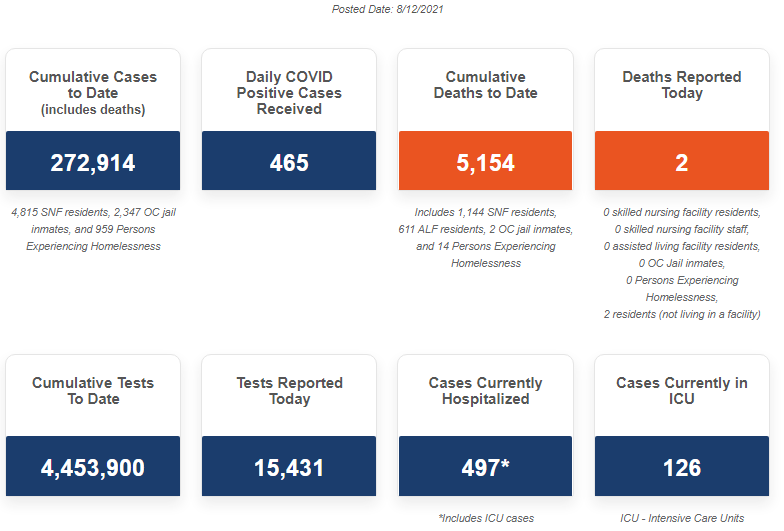Orange County’s COVID-19 hospitalizations remained about the same, but the number of patients in intensive care units increased by 30, according to the latest data reported.
The Orange County Health Care Agency on Thursday reported that hospitalizations due to the virus increased from 495 Wednesday to 497, while the ICU total rose from 96 to 126.
Andrew Noymer, an epidemiologist and UC Irvine professor of population health and disease prevention, said it was encouraging that hospitalizations overall did not increase.
“Hospitalizations are the same as yesterday and that’s very good news,” Noymer told City News Service on Thursday. “The ICU is up, but those numbers are difficult to interpret.”
There are many factors involved in a doctor’s decision to move a patient to intensive care, Noymer said. It doesn’t mean the patients in ICU are in critical condition or fighting for their lives.
“What constitutes an ICU bed is kind of a judgment call inside the hospital,” Noymer said. “If the overall hospitalization hasn’t changed, then that’s good because it means the severity of the county level hasn’t changed and hopefully will be going down soon.
“What gives me the heebie jeebies is overall hospitalization. I’m not saying the ICU is good news, it’s clearly not good news. But I really am pleased we didn’t see another increase in hospitalization.”
Orange County CEO Frank Kim told City News Service the trend has been that at least 20% of those hospitalized will end up in intensive care. Officials believe they will “have more clarity in the next two weeks,” Kim said.
If hospitalizations level off, then the surge will recede, but if they keep increasing, then “it’s something more difficult to manage,” Kim said.
Overall, the county’s hospitals have enough staff and beds to handle this summer surge, Kim said.
Dr. Colleen Cunningham, the chief pediatrician at Children’s Hospital of Orange County, said the facility has admitted about 600 children during the pandemic for COVID-19.
“Earlier this summer there were many days we didn’t have a single child at CHOC,” Cunningham said in a media briefing organized by Orange County Supervisor Katrina Foley.
“It was starting to feel like the worst was over. … Since early July we started seeing a steady increase in children with COVID.”
There were 10 COVID-19 patients at CHOC, with half in intensive care, Cunningham said. None of them are vaccinated, she said.
“They are seriously ill,” Cunningham said. “These are not kids with a runny nose.”
Cunningham acknowledged that children are less likely to experience serious illness from COVID-19, “but they are not immune and some can get seriously ill.”
Many children experience mild symptoms to COVID-19 initially, but later end up at the hospital because they’ve developed pneumonia or Multisystem Inflammatory Syndrome, or MIS-C, Cunningham said.
MIS-C can cause damage to the heart and other organs, Cunningham said. CHOC has treated 77 patients for MIS-C stemming from COVID-19, she said.
Some of the hospital’s patients have developed long-hauler symptoms of COVID-19, she said.
Cunningham advocated more masking and social distancing in an attempt to help curb the spread of the virus.
“Children will wear masks if adults encourage them to wear them,” she said “It’s not to just prevent infection of the person wearing a mask,” she said, adding the masks also prevent transmission of the virus.
Because children can experience such mild symptoms to COVID-19 they might shed it without knowing, Cunningham said.
“We must do all we can to keep children safe,” Cunningham said.
Noymer underscored that previously infected residents should understand they can get it again. The Delta variant, he said, is “much more contagious and people can get infected twice.”
The last time Orange County had this many COVID-19 patients in intensive care was the end of February. The last time hospitalizations were this was high was Feb. 25.
The county has 18.9% of its ICU beds available and 71% of its ventilators.
The summer peak last year was 722 hospitalized patients, Noymer said.
Hospitalizations are the most important metric public health experts are watching, because infection rates could be driven by a higher demand in testing or breakthrough infections of vaccinated people who usually experience little to no symptoms.
The county also reported 465 new infections Thursday, raising the total to 272,914 since the pandemic began.
Two deaths were logged, with one happening July 22 and the other on Aug. 1, the first death for this month.
The death toll for July is 13; 16 for June; 22 for May; 43 for April; 199 for March; 612 for February; 1,563 for January — the deadliest month of the pandemic — and 968 for December, the next deadliest.
The county’s cumulative death toll is 5,154.
Experts expect fewer deaths because the demographic of patients is skewing younger than the winter surge. Now, there are vaccines available to every age group over the age of 12, and the vast majority of the county’s seniors — the most vulnerable to COVID-19 — are vaccinated.
The county on Thursday updated its vaccination numbers. The county has 1,941,560 fully vaccinated residents out of a population of about 3.2 million, including 127,665 who have received the one-dose Johnson & Johnson shot.
The number of residents who have received at least one shot of the two- dose vaccines from Pfizer and Moderna is at 232,057, and a majority of them will get their second shot, experts say.
The case rate for fully vaccinated residents is significantly lower than the case rate for not fully vaccinated residents, according to the Orange County Health Care Agency. According to an update on Thursday, the seven-day case rate is 7.4 per 100,000 for fully vaccinated, but 40.1 for not fully vaccinated.
Noymer said he supported Gov. Gavin Newsom’s announcement Wednesday that all school employees must be vaccinated by mid-October, or face weekly testing for COVID-19.
“The big picture is that what Newsom announced I support, but I think it should be stricter,” Noymer said.
Weekly testing will catch most people who are infected, but “it leaves the door open a crack for transmission,” Noymer said.
The county reported 15,431 tests on Thursday, raising the cumulative total to 4,453,900. The higher demand for COVID-19 testing might be driven by requirements from the state and employers, Kim said.







